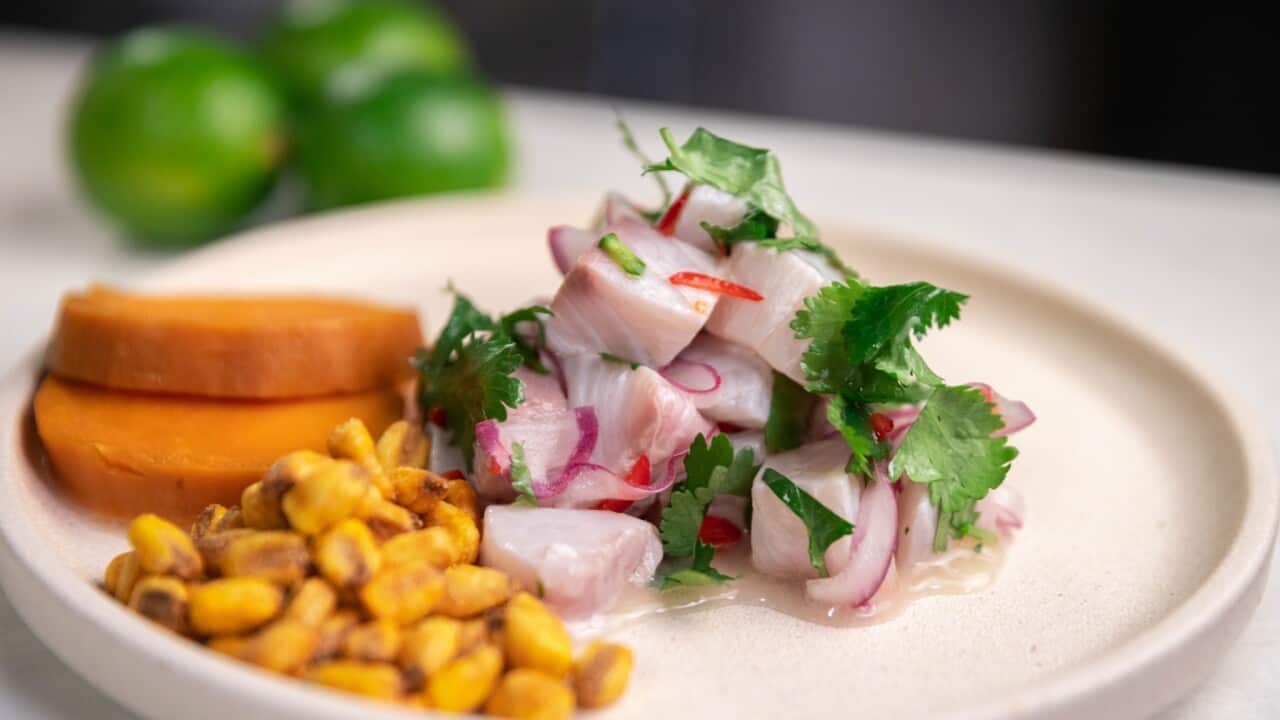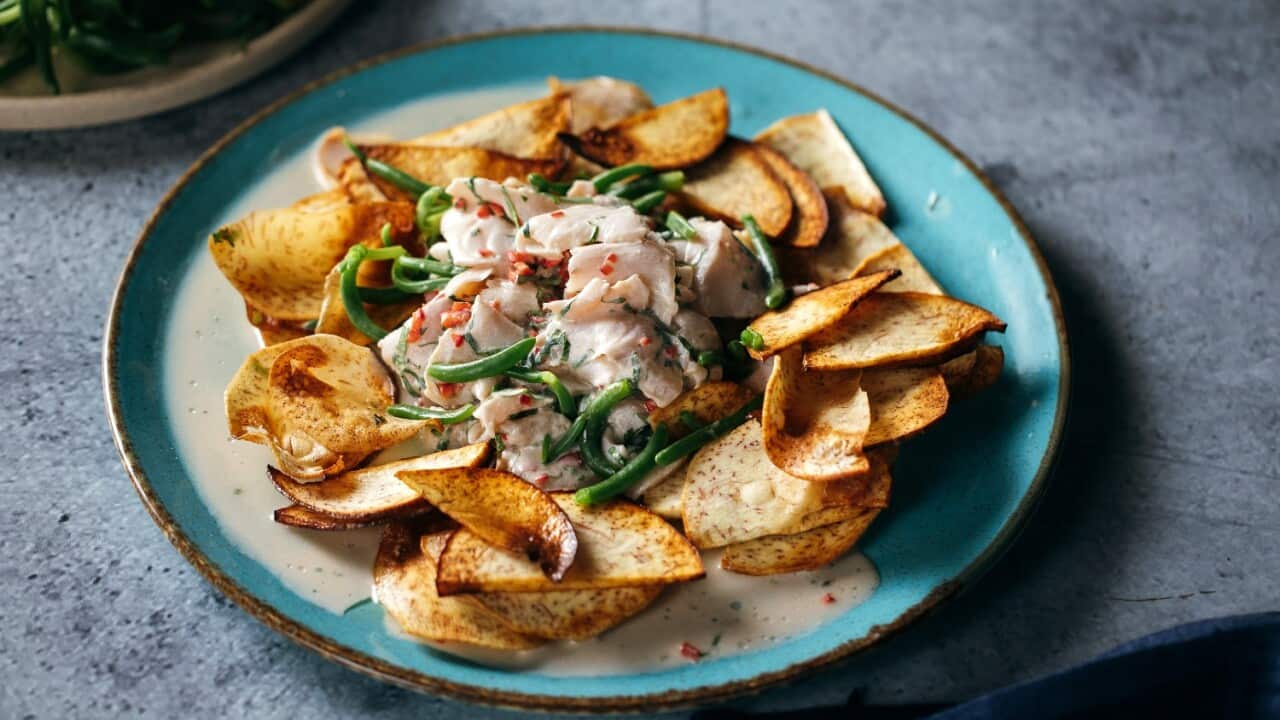--- Join chef Dan Hong in his kitchen where he cooks up global street food favourites in The Streets with Dan Hong, Thursdays 4 August on SBS Food and streaming free on SBS On Demand. For recipes and more head to the . ----
"The true origin of ceviche as we know it is hotly contested," says chef and host of The Streets, Dan Hong.
"The Moche tribes of Peru prepared fish with the juice of a local passionfruit known as 'tumbo' 2,000 years ago. Then the Spanish arrived some 400 years ago with their exotic produce and it was goodbye tumbo, hello lime and coriander."
After that, came the immigration of people from Japan. "Who, let's face it, know a thing or two about eating raw fish," says Hong. "[They] hopped across the Pacific and taught the Peruvians there was no need to cook the fish for hours in citrus, that it could be smothered in all the good juices immediately prior to serving." Although ceviche is found at plenty of higher-scale restaurants around Australia, you can get it as street food throughout Central and South America.
Although ceviche is found at plenty of higher-scale restaurants around Australia, you can get it as street food throughout Central and South America.

Ceviche balanced out with toasted corn and sweet potato. Source: Pastuso
Ceviche is one of the best-selling items at , a renowned Peruvian restaurant in Melbourne's CBD. Head chef Samuel Rivas, who is of Peruvian and Venezuelan background, also runs ceviche masterclasses at the restaurant.
When making ceviche, you want to use a white fish with a super clean flavour.
"When making ceviche, you want to use a white fish with a super clean flavour," says Rivas.
"I'd always say to customers to go with snapper. You could also use bonito, Spanish mackerel, but [you] shouldn't use fish that is super oily or with a flavour too strong, like salmon or tuna," he says. There are three more important things that make good ceviche. One: the fish must be fresh and high-quality. Two: the ingredients need to be fridge-cold when preparing. And, three: you ideally want to prepare it 30 minutes before eating. The fact that it's so quick and easy to prepare makes it the perfect midweek meal.
There are three more important things that make good ceviche. One: the fish must be fresh and high-quality. Two: the ingredients need to be fridge-cold when preparing. And, three: you ideally want to prepare it 30 minutes before eating. The fact that it's so quick and easy to prepare makes it the perfect midweek meal.

Pastuso restaurant uses trout instead of fatty salmon. Source: Pastuso
The art of curing fish spans the globe, as we explore in this article. Read on for cured fish recipes – some classic, others modern.
Peruvian ceviche
A traditional Peruvian ceviche comprises of diced fish pieces, which are about 2cm by 2cm. "Not too small because it will cure too quickly," says Rivas.
DAN HONG'S PERUVIAN CEVICHE RECIPE

Peruvian ceviche
First, you salt the fish, slice up some red onion, then add citrus to cure the fish. "You can use lime juice, or a combination of lemon and lime."
Rivas accompanies it with some sweet potato to neutralise the flavours. "If you can also get some toasted corn, that would also be amazing." This is available at Latin food stores.
Coconut sambal ceviche
In episode four of The Streets, Dan Hong prepares an Asian take on ceviche. He starts by slicing kingfish into super thin, noodle-like strips. This means the fish very quickly soaks up the marinade – a combination of coconut cream, sambal, fish sauce and lime. He then adds cherry tomatoes, spring onion and coriander.
He starts by slicing kingfish into super thin, noodle-like strips. This means the fish very quickly soaks up the marinade – a combination of coconut cream, sambal, fish sauce and lime. He then adds cherry tomatoes, spring onion and coriander.

Asian style ceviche with coconut. Source: SBS Food
These are like the caviar of the citrus world.
Hong serves his ceviche so it's laid out a little bit flat as opposed to piled up. He adds some of the dressing and crowns the dish with some native finger lime for acidity. "These are like the caviar of the citrus world," says Hong.
ALL THE FLAVOUR

Asian style ceviche with coconut
Instead of tostadas, Hong serves this ceviche with prawn crackers, which are great for holding the ceviche and its juices without fully falling apart.
Kokoda
is a traditional Fijian dish. It has similarities to Hong's Asian-style ceviche but it's more of a "soupy" version, according to Brisbane-based chef Louis Tikaram, who spent his pre-teens in Fiji with his family (including his Fijian father). The dish is commonly part of a shared meal, enjoyed on its own or with steamed rice. Tikaram makes kokoda by combining pieces of snapper that are cut across the grain with freshly made coconut milk and lime. He adds cherry tomatoes, shallot, a bird's eye chilli and red chilli.
Tikaram makes kokoda by combining pieces of snapper that are cut across the grain with freshly made coconut milk and lime. He adds cherry tomatoes, shallot, a bird's eye chilli and red chilli.

Fijian ceviche (kokoda). Source: Sharyn Cairns
As kokoda contains a lot of coconut milk, it hinders the lime's ability to cure the fish too much. Here, lime is used more for flavour than a dominant curing agent. The result is a dish that is sour, salty, hot and umami-packed at the same time.
Namas
is a dish commonly found in Badu, an island in the Torres Strait. It has been influenced by the flavours of Japan, back from the pearling era.
Flavours of the Torres Strait

Namas
Fresh snapper is combined with brown onion, slices of orange and red and green chilli. The acidity comes from a combination of lime, lemon, vinegar and sometimes soy sauce. It can also contain coconut milk like the kokoda. The fish and solid ingredients are separated from the liquid before serving. This is also often enjoyed with steamed rice. It's simple, fragrant, spicy and acidic.




